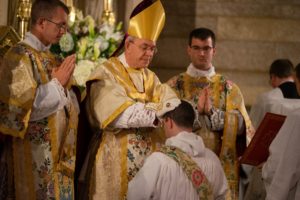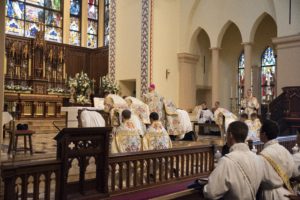Signs and Churches
by Fr. William Rock, FSSP
It would be difficult to overstate the important role which signs hold in Catholicism.
 They are, in fact, everywhere and are foundational to the Catholic system. The Sacraments are sacred signs instituted by Christ which confer grace. The Sacraments and Sacramentals are signs which declare the Church’s faith (see S.T. III, q. 61, a. 4, c). The words of Scripture and the words and gestures of the Liturgical rites are all signs. St. Thomas teaches that the Sacramental Characters of Baptism and Orders empower their possessors to receive and confer sacred signs respectively (see S.T. III, q. 63, especially, a. 2, c and a. 4, ad. 3).
They are, in fact, everywhere and are foundational to the Catholic system. The Sacraments are sacred signs instituted by Christ which confer grace. The Sacraments and Sacramentals are signs which declare the Church’s faith (see S.T. III, q. 61, a. 4, c). The words of Scripture and the words and gestures of the Liturgical rites are all signs. St. Thomas teaches that the Sacramental Characters of Baptism and Orders empower their possessors to receive and confer sacred signs respectively (see S.T. III, q. 63, especially, a. 2, c and a. 4, ad. 3).
But the question may be rightly asked: what exactly is a sign?
According to Words of Wisdom – A Philosophical Dictionary for the Perennial Tradition, a sign is “a linguistic or other type of thing used to represent something else” (s.v. “Sign”). To put it more simply, a sign points to something beyond itself.
Some signs are natural. For example, smoke is a sign: it points to fire. Other signs are produced by intelligences, and these are called conventional signs. A traffic light is such a sign: a man-made sign, with the different colored lights pointing to, indicating, what actions the drivers should take.
Words are signs, as they point to ideas and realities beyond just an arrangement of shapes or sounds. The word “dog,” whether written or spoken, expresses, or points to, the idea one has of dog in the intellect and/or the dog which exists in reality.
God Himself also makes use of signs.
 Christ instituted the Sacraments. Sacred Scripture, written under the inspiration of God, is a collection of signs. By way of example, the word “ark” written on the page points to the ark which really existed and was built by Noah. But the use of signs in Sacred Scripture goes deeper than this. As St. Thomas wrote, “the author of Holy Writ is God, in whose power it is to signify His meaning, not by words only (as man also can do), but also by things themselves” (S.T. I, q. 1, a. 10).
Christ instituted the Sacraments. Sacred Scripture, written under the inspiration of God, is a collection of signs. By way of example, the word “ark” written on the page points to the ark which really existed and was built by Noah. But the use of signs in Sacred Scripture goes deeper than this. As St. Thomas wrote, “the author of Holy Writ is God, in whose power it is to signify His meaning, not by words only (as man also can do), but also by things themselves” (S.T. I, q. 1, a. 10).
God, as He is the Author of reality, can have the realities expressed by the words of Sacred Scripture be themselves signs of other realities. So, while the word “ark” is a sign for the ark which really existed and was built by Noah, the ark which really existed was itself a sign of – it pointed to and expressed characteristics of – the Church.
As the dedications of several churches has been celebrated liturgically this month (the Dedication of the Archbasilica of Our Holy Savior [Archbasilica of Saint John Lateran] on November 9th and the Dedication of the Basilicas of Sts. Peter and Paul on November 18th), it is worth noting that the Church views these buildings, and all church buildings, as signs.
What do church buildings symbolize? To what are they supposed to point? What do they represent? The Neo-Gallican Preface for the Dedication of a Church expresses the following:
You Who being the giver of all good things, dwellest in this house of prayer which we have built, and sanctifiest the Church, which Thou didst found Thyself, with unceasing work. For this is truly the house of prayer, represented by visible buildings, the temple wherein dwelleth Thy glory, the seat of unchanging truth, the sanctuary of eternal charity.
According to the text, the “visible buildings,” the physical church buildings, represent, point to, are signs of, the Church, the Mystical Body of Christ, the truest “house of prayer…the temple wherein dwelleth Thy glory, the seat of unchanging truth, the sanctuary of eternal charity.” This expresses the mind of the Church, that church buildings – temples as the Liturgy calls them – are signs of the Church herself: Militant, Suffering, and Triumphant.
The same sentiment is expressed in the Postcommunion (In anniversario Dedicationis) from the Mass of a Dedication of a Church. In this prayer, the Church prays:
O God, Who from living and chosen stones dost prepare an eternal dwelling-place for Thy majesty; assist Thy suppliant people, that Thy Church, whilst benefitting by material enlargement, may also expand by spiritual increase.
From the text of prayer, it is clear that what is being prayed for is not the material building, but the Church herself, being built up by “living and chosen stones,” the Christian faithful.
 It seems safe to hold, then, that this implies that the stones and other material used to build a church building are signs of these “living and chosen stones” which build up the Church, thus again indicating that the church building is a sign of the Church. The ending of the prayer also indicates that the Church, as expressed by her Liturgy, recognizes a relationship of sign and signified between the church building and the Church herself, for the prayer asks that just as there is a “material enlargement,” an increase in the sign, may the reality to which the sign points, the Church herself, “also expand by spiritual increase.”
It seems safe to hold, then, that this implies that the stones and other material used to build a church building are signs of these “living and chosen stones” which build up the Church, thus again indicating that the church building is a sign of the Church. The ending of the prayer also indicates that the Church, as expressed by her Liturgy, recognizes a relationship of sign and signified between the church building and the Church herself, for the prayer asks that just as there is a “material enlargement,” an increase in the sign, may the reality to which the sign points, the Church herself, “also expand by spiritual increase.”
As it is the Mind of the Church, expressed in the above Preface and Postcommunion, that church buildings are signs of the Church herself, they should be so designed and decorated so as to express this symbolism.
The style of the architecture, even in a simple church, should lift the mind from the day-to-day to things which are spiritual, supernatural, and eternal. Images of the Angels and Saints in the church building are signs of members of the Church Triumphant inhabiting it. It is unfortunate then, when church buildings are built or re-designed in such a way that minimizes this expression.
Reducing the church building to a utilitarian minimum, with an exaggerated focus on the church building being a worship space for the gathered community, serves to obscure the pointing of the church building to the Church herself.
The same is true when the signs used in the Sacraments and Sacramentals are reduced to a bare minimum. Continual exposure to such minimalism can only serve to numb the faithful’s receptively to the signs traditionally use in the Church’s liturgies. Such a numbness not only hinders believers from fully entering into the Church’s practices, but also alienates them from the mindset of their Catholic forbearers.
While it might be true that learning the meanings behind some of the signs used by the Church may take some effort, various resources are available to aid the faithful. Let us then, dear readers, commit ourselves to being immersed in the Church’s language of signs and to having a truly Catholic understanding of Scripture, the Sacraments, Sacramentals, and, indeed, even church buildings themselves.
Fr. William Rock, FSSP was ordained in the fall of 2019 and is currently Assistant Pastor at Mater Misericordiae parish in Phoenix, AZ.
November 23, 2020








